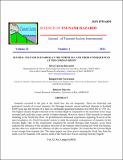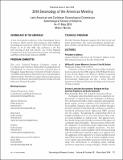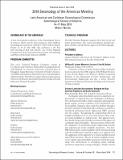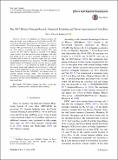| dc.contributor.author | Chacon-Barrantes, Silvia | |
| dc.contributor.author | Narayanan, Rangaswami | |
| dc.contributor.author | Mayerle, Roberto | |
| dc.date.accessioned | 2020-06-16T17:01:04Z | |
| dc.date.available | 2020-06-16T17:01:04Z | |
| dc.date.issued | 2013 | |
| dc.identifier.issn | 87556839 | |
| dc.identifier.uri | http://hdl.handle.net/11056/17576 | |
| dc.description.abstract | Tsunamis occurred in the past at the North Sea, but not frequently. There are historical and geological records of several tsunamis: the Storegga tsunami caused sediment deposits in Scotland 8,000 years ago and records of at least six earthquake-generated tsunamis exist from 842 to 1761 AC. The highest tsunami height witnessed at the German Bight is comparable to the maximum storm surge recorded and could thus cause similar or higher damage. However, there is little research on tsunami modeling in the North Sea. Here, we performed ten numerical experiments imposing N-waves at the open boundaries of a North Sea model system to study the potential consequences of tsunamis for the German Bight. One of the experiments simulated the second Storegga slide tsunami, seven more explored the influence of the incidence direction of the tsunami when entering the North Sea domain, and the other two explored the influence of tides on tsunami heights. We found that the German Bight is not exempt from tsunami risk. The main impact was from waves entering the North Sea from the north, even for tsunamis with sources south of the North Sea. Waves entering from the English Channel were attenuated after crossing the Dover strait. For some scenarios, the tsunami energy got focused directly at the Frisian Islands. The tidal phase had a strong influence on tsunami heights, although in this study the highest heights were obtained in the absence of tides. The duration of tsunamis is significantly smaller than that of storm surges, even though their flow velocities were found to be comparable or larger, thus increasing their possible damage. Therefore, tsunamis should not be dismissed as a threat at the North Sea basin and particularly at the German Bight. | es_ES |
| dc.description.abstract | Los tsunamis ocurrieron en el pasado en el Mar del Norte, pero no con frecuencia. Existen registros históricos y geológicos de varios tsunamis: el tsunami de Storegga causó depósitos de sedimentos en Escocia hace 8,000 años y existen registros de al menos seis tsunamis generados por terremotos desde 842 hasta 1761 AC. La altura más alta del tsunami observada en German Bight es comparable a la marejada ciclónica máxima registrada y, por lo tanto, podría causar daños similares o mayores. Sin embargo, hay poca investigación sobre el modelado de tsunamis en el Mar del Norte. Aquí, realizamos diez experimentos numéricos que imponen ondas N en los límites abiertos de un sistema modelo del Mar del Norte para estudiar las posibles consecuencias de los tsunamis para el Bight alemán. Uno de los experimentos simuló el segundo tsunami de Storegga, siete más exploraron la influencia de la dirección de incidencia del tsunami al ingresar al dominio del Mar del Norte, y los otros dos exploraron la influencia de las mareas en las alturas del tsunami. Descubrimos que el Bight alemán no está exento del riesgo de tsunami. El impacto principal fue de olas que ingresaron al Mar del Norte desde el norte, incluso por tsunamis con fuentes al sur del Mar del Norte. Las olas que ingresan desde el Canal de la Mancha se atenuaron después de cruzar el estrecho de Dover. Para algunos escenarios, la energía del tsunami se concentró directamente en las Islas Frisias. La fase de marea tuvo una fuerte influencia en las alturas del tsunami, aunque en este estudio las mayores alturas se obtuvieron en ausencia de mareas. La duración de los tsunamis es significativamente menor que la de las marejadas ciclónicas, aunque se descubrió que sus velocidades de flujo son comparables o mayores, lo que aumenta su posible daño. Por lo tanto, los tsunamis no deben descartarse como una amenaza en la cuenca del Mar del Norte y, particularmente, en el Bight alemán. | es_ES |
| dc.description.sponsorship | Universidad Nacional, Costa Rica | es_ES |
| dc.language.iso | eng | es_ES |
| dc.publisher | Journal of Tsunami Society International vol.32 no.1 2013 | es_ES |
| dc.rights | Acceso abierto | es_ES |
| dc.subject | TSUNAMI | es_ES |
| dc.subject | TSUNAMI NUMERICAL MODELING | es_ES |
| dc.subject | 1755 LISBON TSUNAMI | es_ES |
| dc.subject | 1929 GRAND BANKS TSUNAMI | es_ES |
| dc.subject | 1858 NORTH SEA TSUNAMI | es_ES |
| dc.subject | SUBMARINE SLIDE TSUNAMI | es_ES |
| dc.title | Several Tsunami Scenarios at the North Sea and their consequences at the German Bight | es_ES |
| dc.type | http://purl.org/coar/resource_type/c_6501 | es_ES |
| dc.description.procedence | SINAMOT | es_ES |
| dc.description.procedence | Departamento de Física | es_ES |




